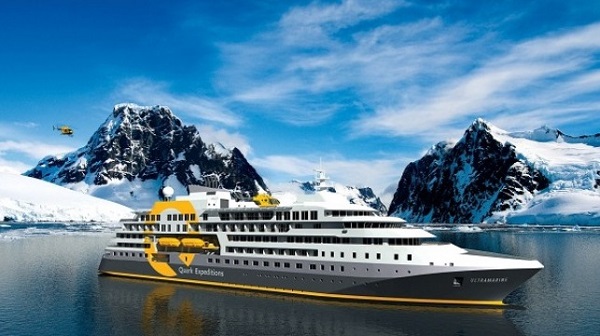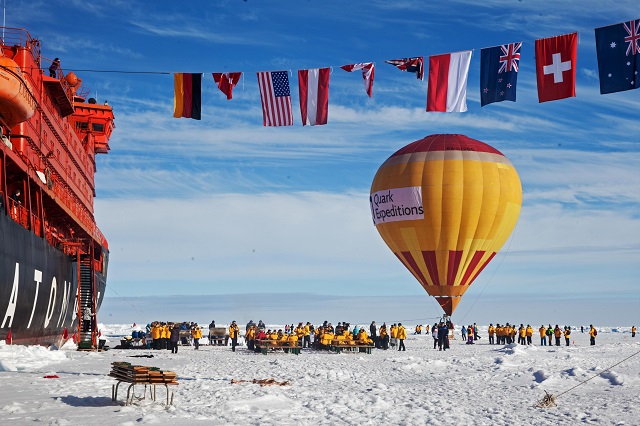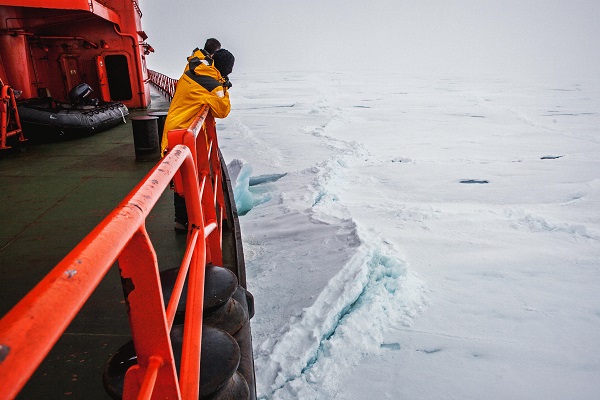Interview: What's New in Polar Cruising with Quark Expeditions
 Quark Expeditions offers an intimate expedition cruise experience on its fleet of polar-class vessels. Lyndsey Lewis, Operations and Sustainability Manager at Quark Expeditions, spoke to The Maritime Executive about what's new in polar expedition cruising.
Quark Expeditions offers an intimate expedition cruise experience on its fleet of polar-class vessels. Lyndsey Lewis, Operations and Sustainability Manager at Quark Expeditions, spoke to The Maritime Executive about what's new in polar expedition cruising.
The company's smaller expedition ships currently include Ocean Adventurer, Ocean Diamond, Ocean Endeavour, World Explorer and the newbuild, Ultramarine. In addition, the company also has the ice-breaker 50 years of Victory.
What sparked the desire to build Ultramarine?

Ultramarine is the culmination of three decades of venturing beyond the predictable in polar exploration. We are always interested in expanding our offerings to take travelers beyond - and she is designed to do just that. She will give polar adventurers unprecedented access to the hardest-to-reach places on the planet.
Equipped with two twin-engine helicopters and setting sail for the first time through the Arctic in 2021, Ultramarine will go where few have ever gone. And, with 20 Zodiacs close to the waterline, guests can engage in more spontaneous experiences and get off the ship in half the time of industry averages. This is polar exploration unlike ever before.
We’re also proud of Ultramarine’s luxe amenities. The ship’s innovative and ultra-spacious impressive design features provide our guests with an authentic, yet innovative and comfortable, exploration experience.
Additionally, Ultramarine solidifies our commitment to environmental responsibility, keeping with our Polar Promise strategy which was unveiled in April 2019 and advances both ongoing and new initiatives aimed at improving environmental and social outcomes in the polar regions. Eco friendly features include: Micro Auto Gasification System (MAGS), four diesel engines to meet fluctuating power needs, a heat recovery system, features like thermal insulation, to keep temperatures stable, eco-friendly lighting and a re-imagined hull and propeller design to ensure the lowest possible resistance, reducing the power required to propel the ship.
Ultramarine will sail to Greenland and also the Canadian Arctic. Are you seeing growing interest in these destinations?
The Canadian Arctic and Greenland offer an enriching, rewarding experience, filled with an abundance of history and wildlife, catering to travelers’ curiosity and desire for exploration. Here, travelers can visit, and learn about, the indigenous communities that live in this area. A great example of this is the Essential Greenland: Southern Coasts and Disko Bay voyage which is offered in Summer 2020 and Summer 2021.
Overall, we’re seeing travelers seek more authentic, meaningful experiences, and travel to the polar regions offers an opportunity to not only visit unique regions on the planet, but also witness the incredible wildlife and the dramatic beauty of these landscapes first-hand.
What other destinations are growing in popularity?
Antarctica continues to be a popular destination for exploration given its breathtaking landscapes, diverse wildlife and element of mystery. And, our Fly/Cruise expeditions allow travelers to explore the continent for as few as eight days making it rather convenient for many.
How important are your on-board experts and the educational opportunities for passengers?
We pride ourselves on offering a standout, holistic experience, and a part of that is educating our passengers on these polar regions.
Quark’s Expedition team members are Polar-passionate, seasoned veterans with rich backgrounds in marine biology, history, geology and more. We offer one of the highest staff-to-guest ratios in the expedition world, meaning more expert guidance for your trip-of-a-lifetime. Additionally, scientists, researchers and special guests provide an inspirational opportunity for guests to learn firsthand, as they are immersed in the wildlife.
The scientists and researchers engage with other passengers and make their knowledge accessible to all travelers through a variety of lectures on board, in their area of expertise. Guests can enjoy anything from formal lectures, to informal talks where they can chat with the scientists and learn more about their work.
Some of the recently launched expeditions, such as the Solar Eclipse voyages of 2021, offer guests the opportunity to learn from impressive and respected eclipse experts. They include NASA’s “Mr. Eclipse,” Fred Espenak; Babak Tafreshi, an award-winning National Geographic photographer; and American Eclipse author David Baron, of the renowned TED Talk, “You owe it to yourself to experience a total solar eclipse.”
What do you see as the ultimate bucket list destination?
One of my personal favorite destinations in the Arctic is the North Pole. It’s truly a remarkable destination and also the first trip Quark Expeditions ever did, which makes it extra-special. There, we offer hot-air ballooning where guests can enjoy spectacular views of the Arctic landscape at 90° North on the largest, most powerful nuclear icebreaker in the world, 50 Years of Victory – a bucket-list worth experience!

In terms of Antarctica, I’d say a visit to the continent itself, is a bucket list item. One of our most popular itineraries is the Antarctic Explorer: Discovering the 7th Continent experience, where guests can check visiting all seven continents off their list, surrounded by remote, untouched scenery and wildlife including penguins, seals and whales.
And, the two recently announced two solar eclipse voyages to Antarctica in 2021 will be incredible. Travelers will have a chance to witness a total solar eclipse, which only occurs about every 400 years on any given place, alongside some of the original solar eclipse team. We are the only team to lead a solar eclipse expedition in Antarctica – having done so in 2003 – and are thrilled to have both Fred Espenak and Babak Tafreshi, joining us, 16 years later.
What passenger demographic do your cruises attract?

An aspect of our experiences that is rather unique is the ability for any age to truly enjoy the unmatched scenery and wildlife that the polar regions offer. Our guests range from solo travelers and couples to large groups and multi-generational families, with ages ranging from eight to 100+. You’ll see families traveling together, just as easily as you’ll see older couples completing a bucket-list trip, or those who love to return.
Most are interested in seeing wildlife in their natural environment (polar bears, penguins, whales, etc.), or learning about polar history, biology and glaciology from globally-recognized guest lecturers.
Equally prevalent are adrenaline-seeking guests who sign up for activities we offer, such as standup paddle boarding, mountaineering or sea kayaking. Quark Expeditions is a global organization, regularly hosting guests from across 52 countries. Although a good portion of our guests are English speakers, usually from North America, Great Britain and Australia, many of our guests also come from non-English speaking countries.
How do you view the growth of expedition cruising?
Expedition cruising has certainly come a long way. Quark Expeditions has focused on polar cruising for nearly 30 years and is poised to be at the forefront of the incredible progress made to exploring these exquisite and remote parts of the world.
With the growing trend in polar travel, we are proud to be one of the few companies to focus strictly on this. We are also aware that expedition travel is changing, as is what travelers are seeking from an expedition. With Ultramarine, we are taking it a step further with an innovative and ultra-spacious vessel whose impressive design features certainly offer an alternate experience to others in our fleet – it is a luxury vessel. Every detail of the ship, no matter how small, has been carefully crafted to optimize the polar expedition experience.
What plans do you have for the future?
We’re constantly looking for ways to cater to our guests’ interests and needs. In fact, Ultramarine is a perfect example of this.
From our guest and market research, we know that many travelers are looking for an authentic expedition experience delivered with comfort and diverse activities as a priority. Ultramarine’s portfolio of adventure options - the broadest in the industry - gives travelers the opportunity to explore these remote, unexplored regions beyond methods offered prior. The ship’s floor to ceiling windows, ample outdoor space for wildlife viewing , quick launching Zodiacs and helicopters, allow passengers to be connected to the outside environment at all times.
Another rapidly growing trend is wellness travel. Guests on board Ultramarine will have access to the Wellness Centre, a modern space featuring three distinct areas where guests can unwind before their next adventure: a luxurious spa with a wide range of treatments, a state-of-the-art sauna featuring floor-to-ceiling windows, and a fully equipped fitness room with separate yoga space.
We recently announced an exciting new voyage that will go to the remote Russian archipelago of Severnaya Zemlya, the last major territorial discovery on the planet. Travelers on these expeditions will enjoy a breathtaking landscape surrounded by stunning view and staggering array of wildlife.
In addition to exploring Severnaya Zemlya, guests on this expedition will also visit glaciated Novaya Zemlya, where the earliest Arctic explorers overwintered, explore historic sites at Franz Josef Land and discover rarely-visited islands of the icy Kara Sea.
We will also have two specialists on board the expeditions. Victor Boyarsky, a renowned Russian polar traveler, the head of the Polar Commission of the Russian Geographical Society, and member of the National Geographic Society of the US and the National Academy of Tourism and Victor Serov, a trained scientist who overwintered at the Soviet Antarctic Station Novolazarevskaya in 1981, led geophysical expeditions to the Russian Arctic from 1982 to 1989 and visited Franz Josef Land in 1984 and 1992 as the Russian leader of an Austrian film that recreated the Tegetthoff expedition (which discovered the archipelago in 1872-74).
